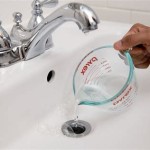How To Wash Clothes In A Sink: A Comprehensive Guide
Washing clothes in a sink, while not the most conventional method in households with washing machines, remains a practical and valuable skill. This technique becomes essential in situations such as travel, when dealing with delicate garments, or during emergencies when conventional laundry facilities are unavailable. This article provides a detailed, step-by-step guide on how to effectively wash clothes in a sink, ensuring clean and well-cared-for items.
Prior to commencing the washing process, gathering the necessary materials and preparing the sink are crucial. The required supplies include a clean sink or basin, mild detergent, a stopper or plug for the sink, cool or lukewarm water, and a clean towel for drying. The type of detergent is important, as harsh chemicals can damage delicate fabrics or leave residue. Mild detergents formulated for delicate garments are generally the preferred choice. Selecting an appropriate sink is also vital. A clean sink prevents dirt or contaminants from transferring to the clothing during the wash. Ensure the sink is thoroughly rinsed and sanitized before use.
Key Point 1: Sorting and Preparing Clothes for Washing
The initial step involves properly sorting the clothes. Sorting prevents color bleeding and avoids potential damage to delicate items. Separate clothes by color: whites, lights, and darks. This segregation will mitigate the risk of dyes from darker fabrics transferring onto lighter colored garments. Furthermore, separating clothes by fabric type is also necessary. Delicate items such as lingerie or silk should be washed separately from more robust fabrics like denim or cotton. This approach protects the integrity of the finer materials and prevents damage from friction or rougher fibers.
Before immersion in water, it is advisable to pre-treat any stains. Addressing stains prior to washing significantly increases the likelihood of successful stain removal. Common staining agents include food spills, dirt, and ink. Apply a small amount of detergent directly onto the stain and gently rub the fabric together. Allow the detergent to sit on the stain for approximately 10 to 15 minutes before rinsing. For persistent stains, consider using a stain remover specifically formulated for the type of stain and fabric. Read and follow the instructions on the stain remover product label carefully.
Another important preparation step is checking the care label of each garment. Care labels provide essential guidance on how to properly wash and dry the item. These labels typically indicate the recommended water temperature, whether the item can be machine washed or requires hand washing, and the appropriate drying method. Adhering to the care label instructions will help to preserve the quality and longevity of the clothing.
Key Point 2: The Washing Process
Once the clothes are sorted, pre-treated, and the sink is prepared, the washing process can begin. The first step involves filling the sink with cool or lukewarm water. Avoid using hot water, as it can cause colors to fade and may damage certain fabrics. The water temperature should be comfortable to the touch but not excessively hot. Add a small amount of mild detergent to the water. The amount of detergent needed will vary depending on the size of the load and the concentration of the detergent. As a general guideline, a teaspoon or tablespoon of detergent is often sufficient for a small load of clothes. Ensure that the detergent is thoroughly dissolved in the water before adding the clothes. This prevents concentrated detergent from coming into direct contact with the fabric and potentially causing damage.
Submerge the clothes in the soapy water. Gently agitate the clothes by hand to ensure thorough saturation. Avoid harsh scrubbing or twisting, as this can damage the fibers. Allow the clothes to soak in the water for approximately 15 to 30 minutes. Soaking helps to loosen dirt and grime, making it easier to remove during the wash cycle. For heavily soiled items, extending the soaking time may be necessary. After soaking, gently wash the clothes by agitating them in the water. Pay particular attention to areas that tend to accumulate dirt, such as underarms and cuffs. Continue washing for several minutes, ensuring that all parts of the garment are properly cleaned.
Once the washing is complete, drain the soapy water from the sink. Rinse the clothes thoroughly with clean, cool water. Continue rinsing until all traces of detergent are removed from the fabric. Residual detergent can leave the clothes feeling stiff and may also irritate the skin. Several rinses may be necessary to completely remove all traces of soap. Gently squeeze the clothes to remove excess water. Avoid wringing the clothes, as this can damage the fibers and cause them to lose their shape. Instead, gently press the water out of the garment. Repeat this process several times until the majority of the water has been removed.
Key Point 3: Drying the Clothes After Washing
Proper drying is a crucial step in the process of washing clothes in a sink, as improper drying can lead to mildew, wrinkling, or damage to the fabric. The initial step involves gently rolling the clothes in a clean, dry towel. This process helps to absorb any remaining excess water. Lay the garment flat on the towel and roll it up tightly, pressing gently to extract moisture. Allow the garment to sit rolled up in the towel for several minutes before unrolling. This method is particularly effective for delicate items that are easily damaged by wringing.
After removing the excess water, the clothes can be air-dried. The ideal location for air-drying is in a well-ventilated area, away from direct sunlight. Direct sunlight can cause colors to fade and may also damage certain fabrics. Hang the clothes on a clothesline or a drying rack. Distribute the weight of the garment evenly to prevent stretching or distortion. If using a clothesline, use clothespins to secure the clothes, placing them on seams or areas that are less visible. Alternatively, lay the clothes flat on a clean, dry surface. Turn the clothes periodically to ensure even drying. Avoid placing clothes directly on wooden surfaces, as the moisture can damage the wood.
For certain items, such as sweaters or delicate knitwear, laying them flat to dry is the preferred method. This prevents the garment from stretching or losing its shape. Place the garment on a clean, dry towel or drying rack, shaping it to its original form. Turn the garment periodically to ensure even drying. Avoid using hangers for these types of items, as they can cause the shoulders to stretch and deform. Inspect the clothes regularly during the drying process to ensure they are drying evenly and to prevent the formation of wrinkles. Once the clothes are completely dry, they can be folded and stored or ironed as needed.
In situations where air-drying is not feasible or practical, a tumble dryer can be used on a low heat setting. However, it is important to note that tumble drying can cause shrinkage and may not be suitable for all types of fabrics. Always check the care label before placing clothes in a tumble dryer. If tumble drying is used, remove the clothes promptly once they are dry to prevent wrinkling. Ironing may be necessary to remove any remaining creases or wrinkles.
Washing clothes in a sink is a valuable skill that can be applied in various situations. By following these detailed steps, individuals can effectively clean their clothes and maintain their garments in good condition, even when access to traditional laundry facilities is limited or unavailable. Proper preparation, careful washing techniques, and appropriate drying methods are key to achieving satisfactory results and prolonging the life of clothing.

How To Do Laundry In Your Sink By Hand And Dry Em Fast
Rick Steves How To Wash Clothes In The Sink While Traveling
Rick Steves How To Wash Clothes In The Sink While Traveling

How To Do Sink Laundry While Traveling Lady Light Travel

Hand Washing Clothes In The Sink Tips And Tricks For Laundry Day

How To Hand Wash Clothes Laundry Tips Downy

How To Wash Clothes In The Sink Practically Spotless

A Step By Guide On How To Hand Wash Clothes

How To Hand Wash Clothes

How To Hand Wash Clothes When Traveling In 2025







